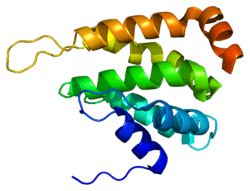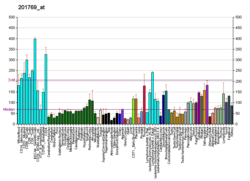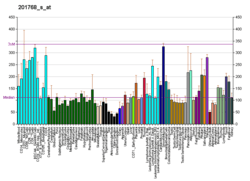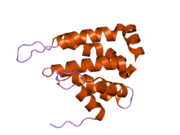CLINT1
Clathrin interactor 1 (CLINT1), also known as EPSIN4, is a protein which in humans is encoded by the CLINT1 gene.[5][6][7]
Function
The CLINT1 protein binds to the terminal domain of the clathrin heavy chain and stimulates clathrin cage vesicle assembly. Clathrin coated vesicles enable neurotransmitter receptors and other proteins to be endocytosed or taken up across neuronal membranes and across the membranes of other types of cells. This enables a turnover of neuroreceptors or other proteins to be maintained and thus the numbers of receptors can be fine tuned.[6]
Clinical significance
The CLINT1 gene has been shown to be involved in the genetic aetiology of schizophrenia in four studies [8][9][10][11][12] It is known that the antipsychotic drugs chlorpromazine and clozapine stabilise clathrin coated vesicles[13][14] and this may be one reason why antipsychotic drugs are effective in treating delusions, auditory hallucinations and many of the other symptoms of schizophrenia.
References
- GRCh38: Ensembl release 89: ENSG00000113282 - Ensembl, May 2017
- GRCm38: Ensembl release 89: ENSMUSG00000006169 - Ensembl, May 2017
- "Human PubMed Reference:". National Center for Biotechnology Information, U.S. National Library of Medicine.
- "Mouse PubMed Reference:". National Center for Biotechnology Information, U.S. National Library of Medicine.
- "Entrez Gene: CLINT1 clathrin interactor 1".
- Wasiak S, Legendre-Guillemin V, Puertollano R, Blondeau F, Girard M, de Heuvel E, Boismenu D, Bell AW, Bonifacino JS, McPherson PS (September 2002). "Enthoprotin: a novel clathrin-associated protein identified through subcellular proteomics". J. Cell Biol. 158 (5): 855–62. doi:10.1083/jcb.200205078. PMC 2173151. PMID 12213833.
- Kalthoff C, Groos S, Kohl R, Mahrhold S, Ungewickell EJ (November 2002). "Clint: a novel clathrin-binding ENTH-domain protein at the Golgi". Mol. Biol. Cell. 13 (11): 4060–73. doi:10.1091/mbc.E02-03-0171. PMC 133614. PMID 12429846.
- Pimm J, McQuillin A, Thirumalai S, Lawrence J, Quested D, Bass N, Lamb G, Moorey H, Datta SR, Kalsi G, Badacsonyi A, Kelly K, Morgan J, Punukollu B, Curtis D, Gurling H (May 2005). "The Epsin 4 gene on chromosome 5q, which encodes the clathrin-associated protein enthoprotin, is involved in the genetic susceptibility to schizophrenia". Am. J. Hum. Genet. 76 (5): 902–7. doi:10.1086/430095. PMC 1199380. PMID 15793701.
- Gurling H, Pimm J, McQuillin A (January 2007). "Replication of genetic association studies between markers at the Epsin 4 gene locus and schizophrenia in two Han Chinese samples". Schizophr. Res. 89 (1–3): 357–9. doi:10.1016/j.schres.2006.08.024. PMID 17070672.
- Tang RQ, Zhao XZ, Shi YY, Tang W, Gu NF, Feng GY, Xing YL, Zhu SM, Sang H, Liang PJ, He L (April 2006). "Family-based association study of Epsin 4 and Schizophrenia". Mol. Psychiatry. 11 (4): 395–9. doi:10.1038/sj.mp.4001780. PMID 16402136.
- Liou YJ, Lai IC, Wang YC, Bai YM, Lin CC, Lin CY, Chen TT, Chen JY (June 2006). "Genetic analysis of the human ENTH (Epsin 4) gene and schizophrenia". Schizophr. Res. 84 (2–3): 236–43. doi:10.1016/j.schres.2006.02.021. PMID 16616458.
- Escamilla M, Lee BD, Ontiveros A, Raventos H, Nicolini H, Mendoza R, Jerez A, Munoz R, Medina R, Figueroa A, Walss-Bass C, Armas R, Contreras S, Ramirez ME, Dassori A (December 2008). "The epsin 4 gene is associated with psychotic disorders in families of Latin American origin". Schizophr. Res. 106 (2–3): 253–7. doi:10.1016/j.schres.2008.09.005. PMID 18929466.
- Phonphok Y, Rosenthal KS (April 1991). "Stabilization of clathrin coated vesicles by amantadine, tromantadine and other hydrophobic amines". FEBS Lett. 281 (1–2): 188–90. doi:10.1016/0014-5793(91)80390-O. PMID 1901801.
- Claing A, Perry SJ, Achiriloaie M, Walker JK, Albanesi JP, Lefkowitz RJ, Premont RT (February 2000). "Multiple endocytic pathways of G protein-coupled receptors delineated by GIT1 sensitivity". Proc. Natl. Acad. Sci. U.S.A. 97 (3): 1119–24. doi:10.1073/pnas.97.3.1119. PMC 15541. PMID 10655494.
External links
- Human CLINT1 genome location and CLINT1 gene details page in the UCSC Genome Browser.
Further reading
- Nagase T, Seki N, Ishikawa K, et al. (1996). "Prediction of the coding sequences of unidentified human genes. V. The coding sequences of 40 new genes (KIAA0161-KIAA0200) deduced by analysis of cDNA clones from human cell line KG-1". DNA Res. 3 (1): 17–24. doi:10.1093/dnares/3.1.17. PMID 8724849.
- Hoja MR, Wahlestedt C, Höög C (2000). "A visual intracellular classification strategy for uncharacterized human proteins". Exp. Cell Res. 259 (1): 239–46. doi:10.1006/excr.2000.4948. PMID 10942595.
- Wasiak S, Legendre-Guillemin V, Puertollano R, et al. (2002). "Enthoprotin: a novel clathrin-associated protein identified through subcellular proteomics". J. Cell Biol. 158 (5): 855–62. doi:10.1083/jcb.200205078. PMC 2173151. PMID 12213833.
- Kalthoff C, Groos S, Kohl R, et al. (2003). "Clint: a novel clathrin-binding ENTH-domain protein at the Golgi". Mol. Biol. Cell. 13 (11): 4060–73. doi:10.1091/mbc.E02-03-0171. PMC 133614. PMID 12429846.
- Strausberg RL, Feingold EA, Grouse LH, et al. (2003). "Generation and initial analysis of more than 15,000 full-length human and mouse cDNA sequences". Proc. Natl. Acad. Sci. U.S.A. 99 (26): 16899–903. doi:10.1073/pnas.242603899. PMC 139241. PMID 12477932.
- Mills IG, Praefcke GJ, Vallis Y, et al. (2003). "EpsinR: an AP1/clathrin interacting protein involved in vesicle trafficking". J. Cell Biol. 160 (2): 213–22. doi:10.1083/jcb.200208023. PMC 2172650. PMID 12538641.
- Hirst J, Motley A, Harasaki K, et al. (2003). "EpsinR: an ENTH domain-containing protein that interacts with AP-1". Mol. Biol. Cell. 14 (2): 625–41. doi:10.1091/mbc.E02-09-0552. PMC 149997. PMID 12589059.
- Wasiak S, Denisov AY, Han Z, et al. (2004). "Characterization of a gamma-adaptin ear-binding motif in enthoprotin". FEBS Lett. 555 (3): 437–42. doi:10.1016/S0014-5793(03)01299-7. PMID 14675752.
- Ota T, Suzuki Y, Nishikawa T, et al. (2004). "Complete sequencing and characterization of 21,243 full-length human cDNAs". Nat. Genet. 36 (1): 40–5. doi:10.1038/ng1285. PMID 14702039.
- Saint-Pol A, Yélamos B, Amessou M, et al. (2004). "Clathrin adaptor epsinR is required for retrograde sorting on early endosomal membranes". Dev. Cell. 6 (4): 525–38. doi:10.1016/S1534-5807(04)00100-5. PMID 15068792.
- Jin J, Smith FD, Stark C, et al. (2004). "Proteomic, functional, and domain-based analysis of in vivo 14-3-3 binding proteins involved in cytoskeletal regulation and cellular organization". Curr. Biol. 14 (16): 1436–50. doi:10.1016/j.cub.2004.07.051. PMID 15324660.
- Hirst J, Miller SE, Taylor MJ, et al. (2005). "EpsinR is an adaptor for the SNARE protein Vti1b". Mol. Biol. Cell. 15 (12): 5593–602. doi:10.1091/mbc.E04-06-0468. PMC 532037. PMID 15371541.
- Gerhard DS, Wagner L, Feingold EA, et al. (2004). "The status, quality, and expansion of the NIH full-length cDNA project: the Mammalian Gene Collection (MGC)". Genome Res. 14 (10B): 2121–7. doi:10.1101/gr.2596504. PMC 528928. PMID 15489334.
- Pimm J, McQuillin A, Thirumalai S, et al. (2005). "The Epsin 4 gene on chromosome 5q, which encodes the clathrin-associated protein enthoprotin, is involved in the genetic susceptibility to schizophrenia". Am. J. Hum. Genet. 76 (5): 902–7. doi:10.1086/430095. PMC 1199380. PMID 15793701.
- Rual JF, Venkatesan K, Hao T, et al. (2005). "Towards a proteome-scale map of the human protein-protein interaction network". Nature. 437 (7062): 1173–8. doi:10.1038/nature04209. PMID 16189514.
- Tang RQ, Zhao XZ, Shi YY, et al. (2006). "Family-based association study of Epsin 4 and Schizophrenia". Mol. Psychiatry. 11 (4): 395–9. doi:10.1038/sj.mp.4001780. PMID 16402136.
- Olsen JV, Blagoev B, Gnad F, et al. (2006). "Global, in vivo, and site-specific phosphorylation dynamics in signaling networks". Cell. 127 (3): 635–48. doi:10.1016/j.cell.2006.09.026. PMID 17081983.







